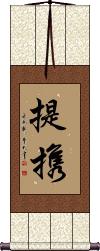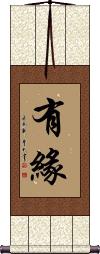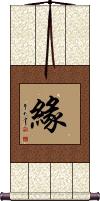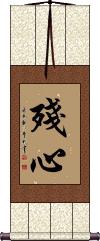Many custom options...
And formats...

Link in Chinese / Japanese...
Buy a Link calligraphy wall scroll here!
Personalize your custom “Link” project by clicking the button next to your favorite “Link” title below...
Guide / Help / Cooperate
提携 varies a bit depending on which language you are reading it in.
提携 means to guide and help (younger people) in Chinese.
Cooperation or “working in concert” in Korean.
And cooperation, tie-up, joint business, and link-up in Japanese.
Karma Connection
有緣 means: related; brought together by fate; same karma; those who have the cause, link, or connection.
有緣 is a common word in Chinese but usually only used in the context of Buddhism in Japanese.
Buddhists will say this refers to those that are influenced by and responsive to the Buddha.
Bond
This Kanji represents a bond, as in the bond between mother and daughter, father and son, family ties, or a family bond.
絆 is the kind of character that says, no matter what happens (difficult times), we have this bond that cannot be broken.
If you go to the Japanese dictionary, the definition is the bonds (between people), (emotional) ties, relationship, connection, link, tether, or fetters.
Read this before ordering...
This Kanji is best if your audience is Japanese. While this is also a Chinese character, it has a completely different meaning in Chinese (it means to hinder or stumble in Chinese).
it’s
a very rare character in Korean Hanja but does mean bond in Korean (used in Korean words for certain kinds of glue and sticking plaster).
The Mysterious Bond Between People
The invisible force that brings people together forever
緣 represents the fate that brings and bonds people together.
緣 is a complicated single character. It can mean a lot of different things depending on how you read it.
In Japanese, it can mean fate, destiny, a mysterious force that binds two people together, a relationship between two people, bond, link, connection, family ties, affinity, opportunity, or chance (to meet someone and start a relationship). It can also mean “someone to rely on,” relative, reminder, memento, or the female given name, Yori.
It's the same in Chinese, where it's defined as cause, reason, karma, fate, or predestined affinity.
In the Buddhist context, it's Pratyaya. This is the concept of indirect conditions, as opposed to direct causes. It's when something happens (meeting someone) by circumstance or a contributing environment. Instead of a direct cause or act, it is a conditioning cause without direct input or action by the involved people.
Occasionally, this character is used in a facetious way to say hem, seam, or edge of clothing. In this case, it's the seam that brings or holds the clothing together.
![]() Note: Japanese will tend to use the variant of this Kanji shown to the right. If you want this version (and are ordering this from the Japanese master calligrapher), click on the Kanji at the right instead of the button above.
Note: Japanese will tend to use the variant of this Kanji shown to the right. If you want this version (and are ordering this from the Japanese master calligrapher), click on the Kanji at the right instead of the button above.
Lingering Mind
Zanshin
First off, 殘心 should only be used in the context of Japanese martial arts. In Chinese, it's a rather sad title (like a broken heart). In Chinese, the first character alone means destroyed, spoiled, ruined, injured, cruel, oppressive, savage, incomplete, or disabled. However, in Japanese, it's remainder, leftover, balance, or lingering.
The second character means heart, mind, soul, or essence in both languages.
殘心 is one of the five spirits of the warrior (budo) and is often used as a Japanese martial arts tenet. Under that context, places such as the Budo Dojo define it this way: The spirit of zanshin is the state of the remaining or lingering spirit. It is often described as a sustained and heightened state of awareness and mental follow-through. However, true zanshin is a state of focus or concentration before, during, and after the execution of a technique, where a link or connection between uke and nage is preserved. Zanshin is the state of mind that allows us to stay spiritually connected, not only to a single attacker but to multiple attackers and even an entire context; a space, a time, an event.
![]() In modern Japan (and Simplified Chinese), they use a different version of the first character, as seen to the right. Click on this character to the right instead of the button above if you want this modern Japanese version of lingering mind / zanshin.
In modern Japan (and Simplified Chinese), they use a different version of the first character, as seen to the right. Click on this character to the right instead of the button above if you want this modern Japanese version of lingering mind / zanshin.
These search terms might be related to Link:
Bond
Family Bond / Family Ties
Japanese Karate Association
Karma Connection
Relationship
Sisterhood / Association of Women
Sisterhood / Sisters Relationship
The Mysterious Bond Between People
Woman’s Association
Not the results for link that you were looking for?
Below are some entries from our dictionary that may match your link search...
| Characters If shown, 2nd row is Simp. Chinese |
Pronunciation Romanization |
Simple Dictionary Definition |
絆 绊 see styles |
bàn ban4 pan rian りあん |
More info & calligraphy: Bond(1) bonds (between people); (emotional) ties; relationship; connection; link; (2) tether; fetters; (female given name) Rian |
有緣 有缘 see styles |
yǒu yuán you3 yuan2 yu yüan uen |
More info & calligraphy: Karma ConnectionThose who have the cause, link, or connection, i. e. are influenced by and responsive to the Buddha. |
アンカ see styles |
anka アンカ |
More info & calligraphy: Anka |
アンカー see styles |
angaa / anga アンガー |
More info & calligraphy: Anker |
アイリンク see styles |
airinku アイリンク |
{comp} i.LINK; (personal name) Eyring |
摽 see styles |
biào biao4 piao |
to bind tightly; to link (arms); to hang around with; to stick close to (sb); to compete; (literary) to hit; to beat |
環 环 see styles |
huán huan2 huan kan かん |
ring; hoop; loop; (chain) link; classifier for scores in archery etc; to surround; to encircle; to hem in (1) ring; band; rim; (2) {math;chem} ring; (prefix noun) (3) circum-; (female given name) Tamami a jade ring or bracelet |
紲 绁 see styles |
xiè xie4 hsieh setsu せつ |
to tie; to bind; to hold on a leash; rope; cord (1) bonds (between people); (emotional) ties; relationship; connection; link; (2) tether; fetters; (given name) Setsu |
綱 纲 see styles |
gāng gang1 kang tsuna つな |
head rope of a fishing net; guiding principle; key link; class (taxonomy); outline; program (1) rope; cord; line; (2) {sumo} grand champion's braided belt; (given name) Tsunashi A net rope, bond, social nexus, constant obligation, the restraints of society. |
綴 缀 see styles |
zhuì zhui4 chui tsuzuru つづる |
to sew; to stitch together; to combine; to link; to connect; to put words together; to compose; to embellish (1) spelling; (2) orthography; (3) patching; binding; (female given name) Tsuzuru |
聯 联 see styles |
lián lian2 lien tsurane つらね |
(bound form) to ally oneself with; to unite; to combine; to join; (bound form) (poetry) antithetical couplet (personal name) Tsurane to link |
連 连 see styles |
lián lian2 lien ren れん |
to link; to join; to connect; continuously; in succession; including; (used with 也[ye3], 都[dou1] etc) even; company (military) (1) (ateji for "ream"; also written as 嗹) two reams (of paper); 1000 sheets (of paper); (2) (also written as 聯) stanza; verse; (3) {biol} tribe (in taxonomy); (4) (abbreviation) (See 連勝式) forecast (bet); bet which predicts the top 2 finishers (i.e. quinella or perfecta bet); (suffix noun) (5) party; company; group; set; (counter) (6) (also written as 聯) things strung in a line, e.g. pearls, dried fish, spans of a bridge, etc.; (counter) (7) (obsolete) falcon; (surname, given name) Ren To connect, continue; contiguous; and, even. |
銜 衔 see styles |
xián xian2 hsien kutsuwa くつわ |
bit (of a bridle); to hold in the mouth; to harbor (feelings); to link; to accept; rank; title bit (i.e. attached to a bridle) |
鐶 镮 see styles |
huán huan2 huan kan かん |
(ancient weight); metal ring (1) ring; link; (2) open spirals of heavy metal wire twisted into a kettle and used to lift it (tea ceremony); (given name) Tamaki A metal ring; a ring. |
一環 see styles |
ikkan いっかん |
(1) link (e.g. in a chain of events); part (of a plan, campaign, activities, etc.); (can be adjective with の) (2) {bot} monocyclic; (personal name) Kazuwa |
三鍵 三键 see styles |
sān jiàn san1 jian4 san chien |
triple bond (chemistry); triple link |
中介 see styles |
zhōng jiè zhong1 jie4 chung chieh |
to act as intermediary; to link; intermediate; inter-; agency; agent |
六入 see styles |
liù rù liu4 ru4 liu ju rokunyuu / rokunyu ろくにゅう |
{Buddh} six sense organs (eyes, ears, nose, tongue, body, and mind) ṣaḍāyatana; 六阿耶怛那 (or 六阿也怛那) the six entrances, or locations, both the organ and the sensation — eye, ear, nose, tongue, body, and mind; sight, hearing, smell, taste, touch, and perception. The six form one of the twelve nidanas, see 十二因緣. The 六根 are the six organs, the 六境 the six objects, and the 六塵 or guṇas, the six inherent qualities. The later term is 六處 q. v.; The "six entries" ṣaḍāyatana, which form one of the links in the chain of causaton, v. 十二因緣 the preceding link being觸contact, and the succeeding link 識 perception. The six are the qualities and effects of the six organs of sense producing sight, hearing, smell, taste, touch, and thought (or mental presentations). v. also 二入. |
単節 see styles |
tansetsu たんせつ |
(noun - becomes adjective with の) simple link |
卸扣 see styles |
xiè kòu xie4 kou4 hsieh k`ou hsieh kou |
shackle (U-shaped link) |
因み see styles |
chinami ちなみ |
(1) (See 因みに・ちなみに) association; link; connection; (2) pledge (esp. for marriage); promise |
外鏈 外链 see styles |
wài liàn wai4 lian4 wai lien |
(computing) external link (abbr. for 外部鏈接|外部链接[wai4 bu4 lian4 jie1]) |
安価 see styles |
anka あんか |
(noun or adjectival noun) (1) (ant: 高価) low-priced; cheap; inexpensive; (noun or adjectival noun) (2) shallow (e.g. sympathy); superficial; cheap (e.g. government); (3) (net-sl) (See アンカー・6) link back to discussion group, bulletin board, etc. posting |
專線 专线 see styles |
zhuān xiàn zhuan1 xian4 chuan hsien |
special-purpose phone line or communications link; hotline; special rail line (e.g. between airport and city); CL:條|条[tiao2] |
巻く see styles |
maku まく |
(transitive verb) (1) to wind; to coil; to roll; to wear (e.g. turban, scarf); (2) to envelope; to shroud; (3) to outflank; to skirt; (4) to link (verse); (v5k,vi) (5) to move ahead (three hours, etc.); to move up |
捲く see styles |
maku まく |
(transitive verb) (1) to wind; to coil; to roll; to wear (e.g. turban, scarf); (2) to envelope; to shroud; (3) to outflank; to skirt; (4) to link (verse); (v5k,vi) (5) to move ahead (three hours, etc.); to move up |
掛鉤 挂钩 see styles |
guà gōu gua4 gou1 kua kou |
to couple; to link; to hook together; (fig.) (preceded by 與|与[yu3] + {entity}) to establish contact (with {entity}); (Tw) to collude (with {entity}); (fig.) to link (marketing efforts with production etc); to peg (welfare payments to inflation etc); to tie (remuneration to performance etc); hook (on which to hang something); latch hook; coupling |
接続 see styles |
setsuzoku せつぞく |
(noun/participle) (1) connection; attachment; union; join; joint; link; (noun/participle) (2) changing trains; (noun/participle) (3) (abbreviation) (See 接続語) conjunction |
會合 会合 see styles |
huì hé hui4 he2 hui ho |
to meet; to rendezvous; to merge; to link up; meeting; confluence See: 会合 |
染緣 染缘 see styles |
rǎn yuán ran3 yuan2 jan yüan zenen |
The nidāna or link of pollution, which connects illusion with the karmaic miseries of reincarnation. From the 'water' of the bhūtatathatā, affected by the 'waves' of this nidāna-pollution, arise the waves of reincarnation. |
Click here for more link results from our dictionary
The following table may be helpful for those studying Chinese or Japanese...
| Title | Characters | Romaji (Romanized Japanese) | Various forms of Romanized Chinese | |
| Guide Help Cooperate | 提携 | tei kei / teikei | tí xié / ti2 xie2 / ti xie / tixie | t`i hsieh / tihsieh / ti hsieh |
| Karma Connection | 有緣 有缘 | uen | yǒu yuán / you3 yuan2 / you yuan / youyuan | yu yüan / yuyüan |
| Bond | 絆 绊 | kizuna | bàn / ban4 / ban | pan |
| The Mysterious Bond Between People | 緣 / 縁 缘 | en | yuán / yuan2 / yuan | yüan |
| Lingering Mind | 殘心 残心 | zan shin / zanshin | cán xīn / can2 xin1 / can xin / canxin | ts`an hsin / tsanhsin / tsan hsin |
| In some entries above you will see that characters have different versions above and below a line. In these cases, the characters above the line are Traditional Chinese, while the ones below are Simplified Chinese. | ||||
Successful Chinese Character and Japanese Kanji calligraphy searches within the last few hours...








